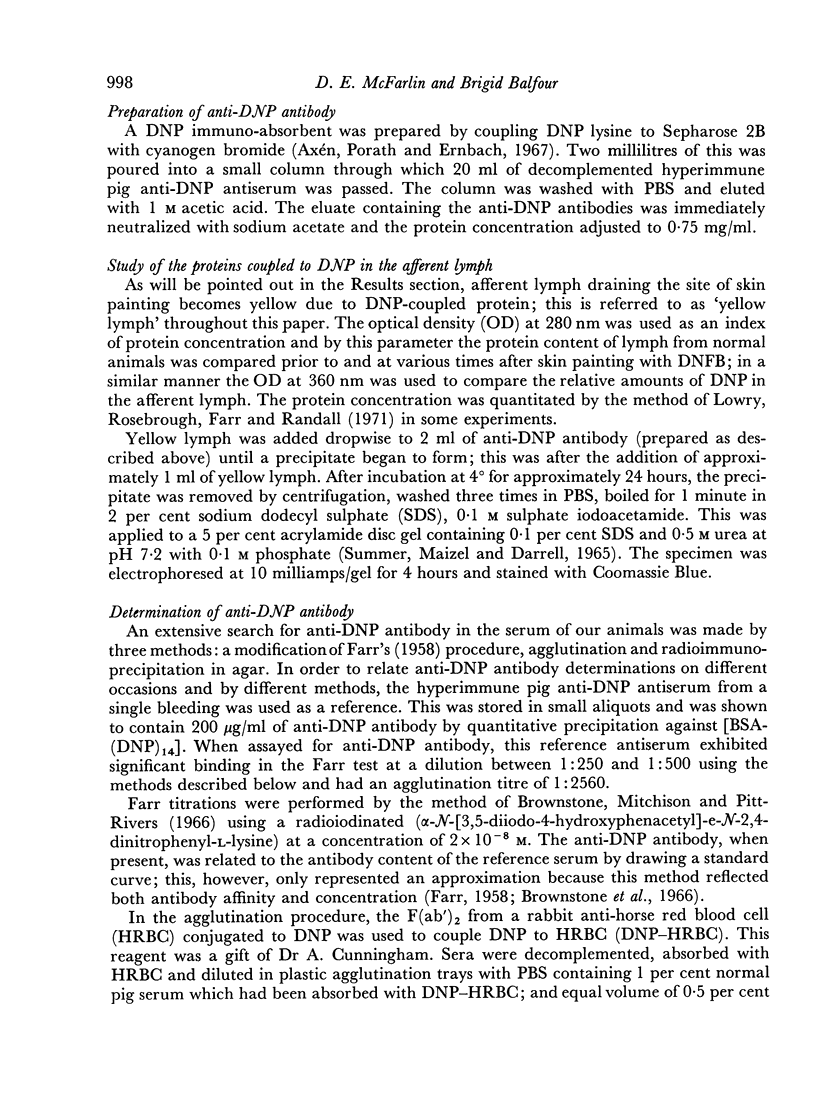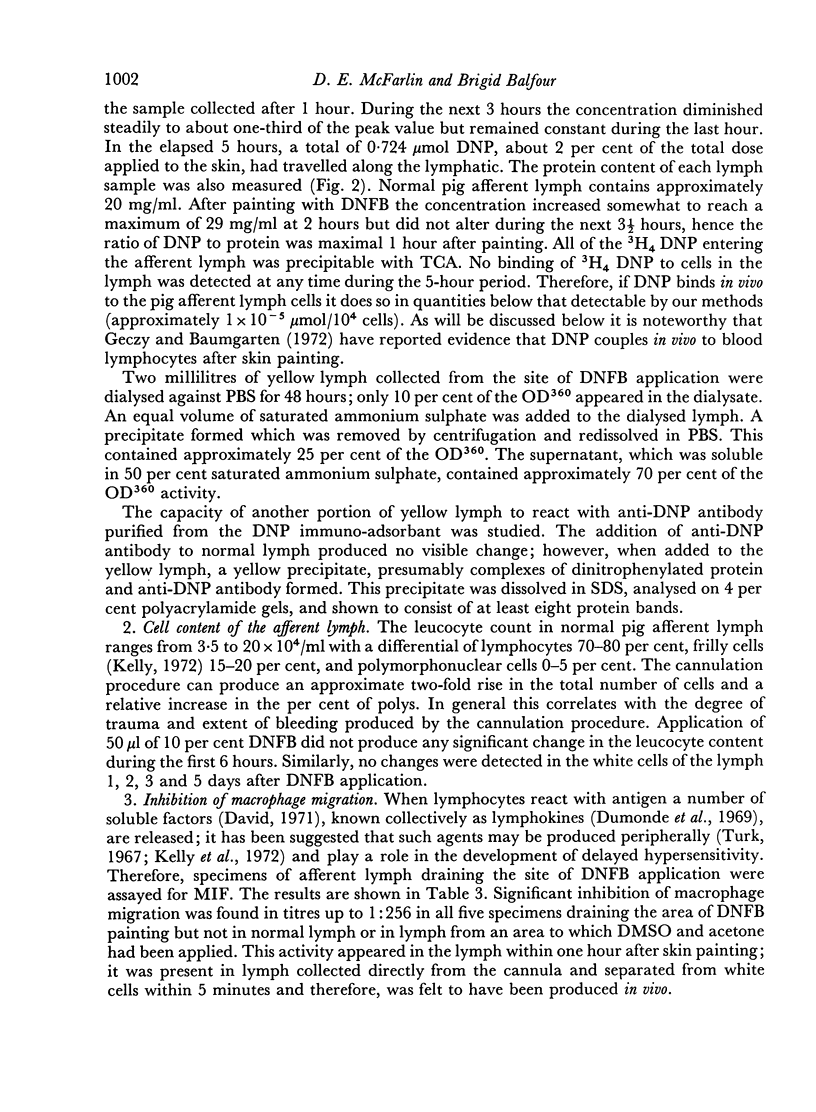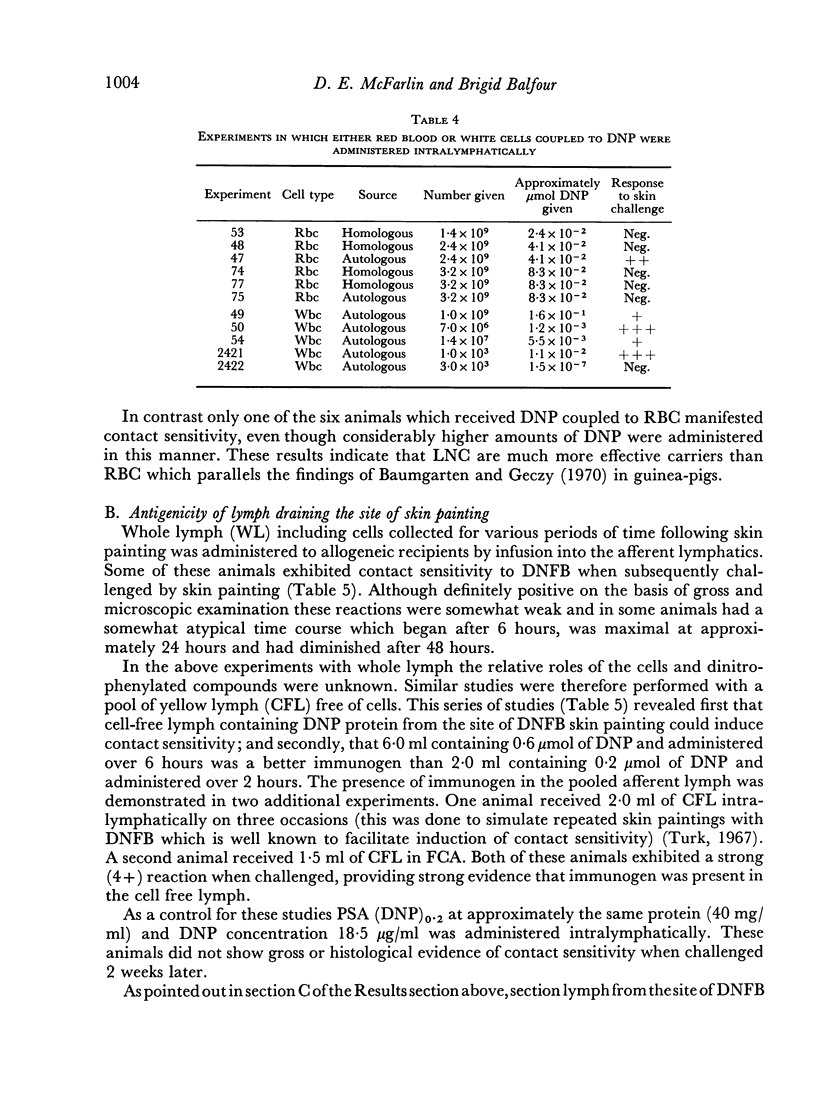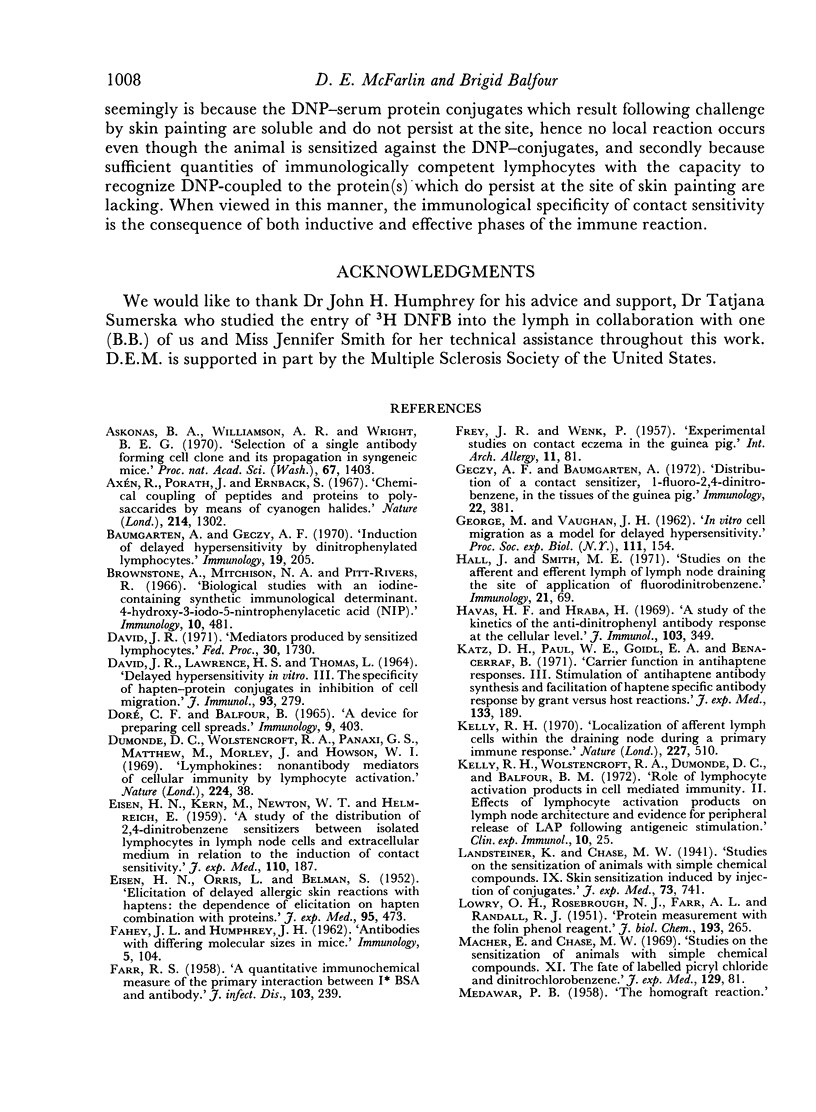Abstract
Following the application of a sensitizing dose of DNFB the afferent lymph draining the site becomes yellow due to the presence of dinitrophenylated proteins. Intralymphatic perfusion of such afferent lymph either whole or cell-free into recipients led to the development of contact sensitivity to DNFB in these animals. All of the OD360, due to the DNP group, in the afferent lymph was precipitable with trichloracetic acid and at least 90 per cent non-dialysable. Preliminary data indicate that the DNP is conjugated to eight or more proteins; however, the chemical nature of the carrier(s) responsible for the induction of contact sensitivity and whether it is derived from interstitial fluid or skin are unknown.
In a second group of experiments, in vitro conjugation of DNP to autologous lymph node cells and subsequent infusion via the afferent lymphatic, induced contact sensitivity against DNFB, and furthermore, very small amounts of DNP administered in this manner were required. In contrast 0.1 μmol of DNP coupled to RBCs did not induce contact sensitivity in five of six experiments.
These results indicate that one mechanism leading to the induction of contact sensitivity to DNFB in the pig is by direct conjugation of this chemical to the specific carrier which subsequently passes to the regional lymph node via the afferent lymph. A second possible mechanism is that DNP at the peripheral site conjugates directly to WBCs which function as carriers. Although we as yet have no evidence that this second possibility occurs in vivo, it remains attractive because of the minute amounts of DNP which can induce contact sensitivity after coupling to lymph node cells in vitro.
Full text
PDF














Selected References
These references are in PubMed. This may not be the complete list of references from this article.
- Askonas B. A., Williamson A. R., Wright B. E. Selection of a single antibody-forming cell clone and its propagation in syngeneic mice. Proc Natl Acad Sci U S A. 1970 Nov;67(3):1398–1403. doi: 10.1073/pnas.67.3.1398. [DOI] [PMC free article] [PubMed] [Google Scholar]
- Axén R., Porath J., Ernback S. Chemical coupling of peptides and proteins to polysaccharides by means of cyanogen halides. Nature. 1967 Jun 24;214(5095):1302–1304. doi: 10.1038/2141302a0. [DOI] [PubMed] [Google Scholar]
- Baumgarten A., Geczy A. F. Induction of delayed hypersensitivity by dinitrophenylated lymphocytes. Immunology. 1970 Aug;19(2):205–217. [PMC free article] [PubMed] [Google Scholar]
- DAVID J. R., LAWRENCE H. S., THOMAS L. DELAYED HYPERSENSITIVITY IN VITRO. 3. THE SPECIFICITY OF HAPTEN-PROTEIN CONJUGATES IN THE INHIBITION OF CELL MIGRATION. J Immunol. 1964 Aug;93:279–282. [PubMed] [Google Scholar]
- David J. R. Mediators produced by sensitized lymphocytes. Fed Proc. 1971 Nov-Dec;30(6):1730–1735. [PubMed] [Google Scholar]
- Doré C. F., Balfour B. M. A device for preparing cell spreads. Immunology. 1965 Oct;9(4):403–405. [PMC free article] [PubMed] [Google Scholar]
- Dumonde D. C., Page D. A., Matthew M., Wolstencroft R. A. Role of lymphocyte activation products (LAP) in cell-mediated immunity. I. Preparation and partial purification of guinea-pig LAP. Clin Exp Immunol. 1972 Jan;10(1):25–47. [PMC free article] [PubMed] [Google Scholar]
- Dumonde D. C., Wolstencroft R. A., Panayi G. S., Matthew M., Morley J., Howson W. T. "Lymphokines": non-antibody mediators of cellular immunity generated by lymphocyte activation. Nature. 1969 Oct 4;224(5214):38–42. doi: 10.1038/224038a0. [DOI] [PubMed] [Google Scholar]
- EISEN H. N., ORRIS L., BELMAN S. Elicitation of delayed allergic skin reactions with haptens; the dependence of elicitation on hapten combination with protein. J Exp Med. 1952 May 1;95(5):473–487. doi: 10.1084/jem.95.5.473. [DOI] [PMC free article] [PubMed] [Google Scholar]
- FAHEY J. L., HUMPHREY J. H. Antibodies with differing molecular sizes in mice. Immunology. 1962 Jan;5:104–109. [PMC free article] [PubMed] [Google Scholar]
- FARR R. S. A quantitative immunochemical measure of the primary interaction between I BSA and antibody. J Infect Dis. 1958 Nov-Dec;103(3):239–262. doi: 10.1093/infdis/103.3.239. [DOI] [PubMed] [Google Scholar]
- FREY J. R., WENK P. Experimental studies on the pathogenesis of contact eczema in the guinea-pig. Int Arch Allergy Appl Immunol. 1957;11(1-2):81–100. doi: 10.1159/000228405. [DOI] [PubMed] [Google Scholar]
- Geczy A. F., Baumgarten A. Distribution of a contact sensitizer, 1-fluoro-2,4-dinitro-benzene, in the the tissues of the guinea-pig. Immunology. 1972 Mar;22(3):381–392. [PMC free article] [PubMed] [Google Scholar]
- Hall J. G., Smith M. E. Studies on the afferent and efferent lymph of lymph nodes draining the site of application of fluorodinitrobenzene (FDNB). Immunology. 1971 Jul;21(1):69–79. [PMC free article] [PubMed] [Google Scholar]
- Havas H. F., Hraba T. A study of the kinetics of the anti-dinitrophenyl antibody response at the cellular level. J Immunol. 1969 Aug;103(2):349–356. [PubMed] [Google Scholar]
- Kelly R. H. Localization of afferent lymph cells within the draining node during a primary immune response. Nature. 1970 Aug 1;227(5257):510–513. doi: 10.1038/227510a0. [DOI] [PubMed] [Google Scholar]
- LOWRY O. H., ROSEBROUGH N. J., FARR A. L., RANDALL R. J. Protein measurement with the Folin phenol reagent. J Biol Chem. 1951 Nov;193(1):265–275. [PubMed] [Google Scholar]
- Macher E., Chase M. W. Studies on the sensitization of animals with simple chemical compounds. XI. The fate of labeled picryl chloride and dinitrochlorobenzene after sensitizing injections. J Exp Med. 1969 Jan 1;129(1):81–102. doi: 10.1084/jem.129.1.81. [DOI] [PMC free article] [PubMed] [Google Scholar]
- OUCHTERLONY O. Diffusion-in-gel methods for immunological analysis. Prog Allergy. 1958;5:1–78. [PubMed] [Google Scholar]
- Oppenheim J. J., Wolstencroft R. A., Gell P. G. Delayed hypersensitivity in the guinea-pig to a protein-hapten conjugate and its relationship to in vitro transformation of lymph node, spleen, thymus and peripheral blood lymphocytes. Immunology. 1967 Jan;12(1):89–102. [PMC free article] [PubMed] [Google Scholar]
- Parker D., Turk J. L. DNP conjugates in guinea-pig lymph nodes during contact sensitization. Immunology. 1970 Jun;18(6):855–864. [PMC free article] [PubMed] [Google Scholar]
- Paul W. E., Katz D. H., Goidl E. A., Benacerraf B. Carrier function in anti-hapten immune responses. II. Specific properties of carrier cells capable of enhancing anti-hapten antibody responses. J Exp Med. 1970 Aug 1;132(2):283–299. doi: 10.1084/jem.132.2.283. [DOI] [PMC free article] [PubMed] [Google Scholar]
- Paul W. E., Siskind G. W., Benacerraf B. Specificity of cellular immune responses. Antigen concentration dependence of stimulation of DNA synthesis in vitro by specifically sensitized cells, as an expression of the binding characteristics of cellular antibody. J Exp Med. 1968 Jan 1;127(1):25–42. doi: 10.1084/jem.127.1.25. [DOI] [PMC free article] [PubMed] [Google Scholar]
- Pomeranz J. R. Immunologic unresponsiveness following a single feeding of picryl chloride. J Immunol. 1970 Jun;104(6):1486–1490. [PubMed] [Google Scholar]
- RAFFEL S., NEWEL J. M. The delayed hypersensitivity induced by antigen-antibody complexes. J Exp Med. 1958 Dec 1;108(6):823–841. doi: 10.1084/jem.108.6.823. [DOI] [PMC free article] [PubMed] [Google Scholar]
- SALVIN S. B., SMITH R. F. The specificity of allergic reactions. III. Contact hypersensitivity. J Exp Med. 1961 Aug 1;114:185–194. doi: 10.1084/jem.114.2.185. [DOI] [PMC free article] [PubMed] [Google Scholar]
- Summers D. F., Maizel J. V., Jr, Darnell J. E., Jr Evidence for virus-specific noncapsid proteins in poliovirus-infected HeLa cells. Proc Natl Acad Sci U S A. 1965 Aug;54(2):505–513. doi: 10.1073/pnas.54.2.505. [DOI] [PMC free article] [PubMed] [Google Scholar]
- Weir D. M., Suckling E. J. Macrophage migration inhibition induced by tissue antigen in guinea-pigs. Clin Exp Immunol. 1971 May;8(5):791–799. [PMC free article] [PubMed] [Google Scholar]


